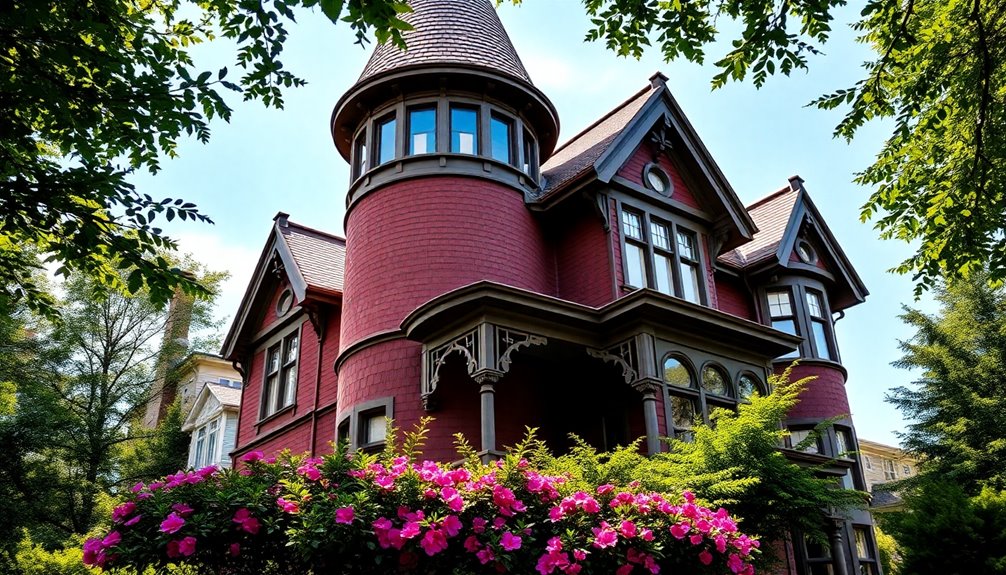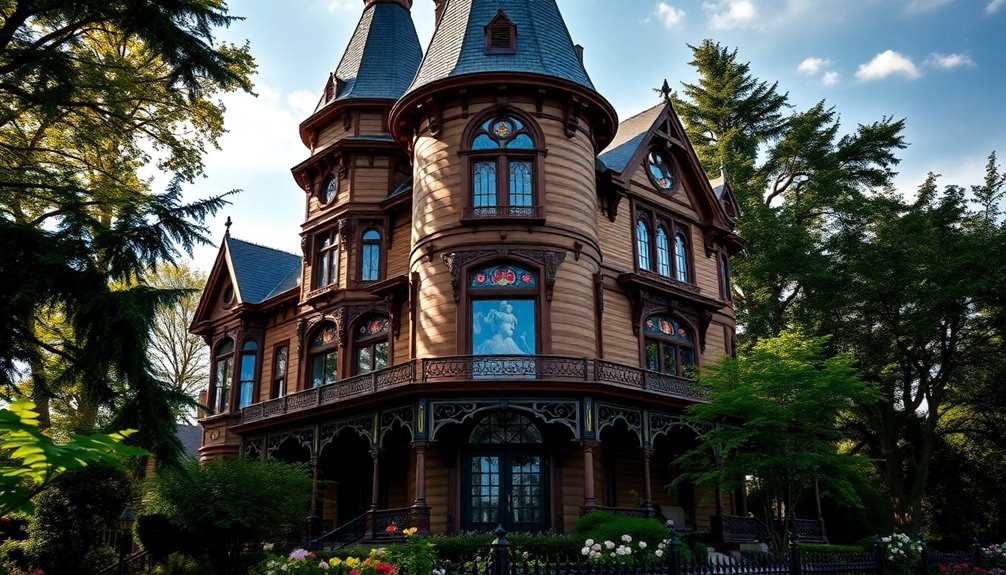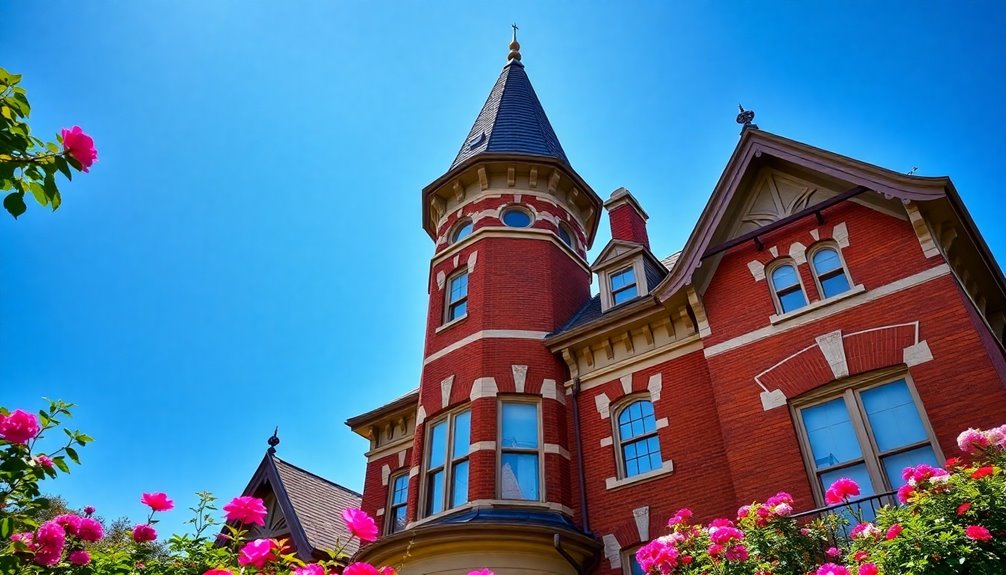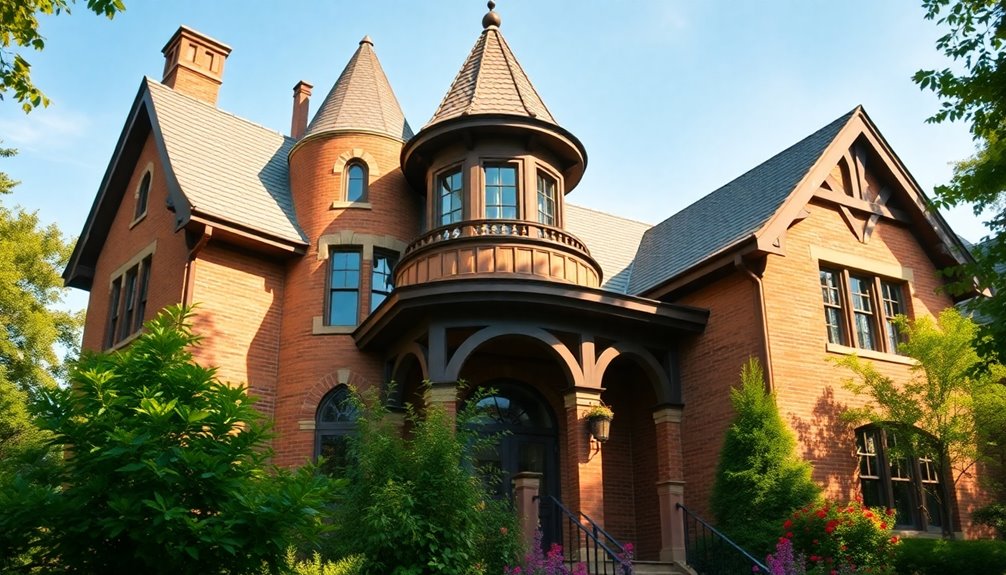If you're curious about housing styles that feature turrets, you'll want to explore the Queen Anne style. This architectural gem flourished in the U.S. between 1880 and 1900, highlighting asymmetrical facades and charming turret designs. These turrets, often circular and topped with unique roofs, add a striking visual appeal to homes, allowing for larger windows and more light. They serve both functional and decorative purposes, making Queen Anne homes stand out in neighborhoods. You'll find plenty of fascinating examples, showcasing the elegance and charm of turreted structures. Discover more about their history and contemporary adaptations.
Key Takeaways
- The Queen Anne architectural style prominently features turrets, characterized by asymmetrical facades and eclectic design elements.
- Victorian architecture frequently incorporates turrets, enhancing both aesthetic appeal and historical significance.
- Modern farmhouse aesthetics have adapted turret designs, blending traditional and contemporary styles.
- Iconic examples of turreted homes include the Leavitt-Hovey House and residences on Woodruff Place Middle Drive.
- Turrets serve as focal points in various architectural styles, symbolizing status and artistic trends of their era.
Understanding Turrets and Towers

When you think about the charm of certain architectural styles, turrets and towers often come to mind as striking features that elevate a home's aesthetic.
Turrets, commonly found in Victorian architecture, serve as decorative elements that enhance the whimsical character of residential construction. These small towers rise above the roof, typically featuring circular shapes and various roof styles, like conical or dome-like designs.
You'll notice that turrets are often integrated into asymmetrical layouts, creating a unique visual appeal alongside bay windows and wrap-around porches. They also allow for large window openings, flooding interiors with natural light and offering stunning views.
Ultimately, turrets embody a blend of functionality and artistry in architectural style, making them an enchanting choice for any home.
The Queen Anne Style

The Queen Anne style captures your imagination with its vibrant eclecticism, blending various architectural elements into an enchanting whole.
Popular in the United States from 1880 to 1900, this style showcases Victorian homes adorned with asymmetrical facades, wrap-around porches, and eye-catching turrets.
These turrets often rise above the main structure, adding both charm and a castle-like allure. Influenced by the Gothic revival style and the Arts and Crafts movement, the Queen Anne style reflects a rich tapestry of design.
Many homes from around 1895 feature intricate details like decorative shingles and unique roof designs, enhancing their visual complexity.
This whimsical design approach, popularized through architectural magazines, has made the Queen Anne style a treasured part of American architecture.
Architectural Features of Turrets

When you look at turrets, you'll notice their distinct circular shapes and how they often rise above the main structure, adding visual interest to a home.
Historically, these features shifted from defensive designs in medieval times to elegant symbols of status in residential architecture.
Understanding their design elements and significance will enhance your appreciation for these enthralling architectural details.
Turret Design Elements
While exploring turret design elements, you'll notice that their distinctive circular form adds a striking visual appeal to any building. Turrets enhance domestic architecture, especially in Victorian architecture and the Queen Anne style, where they serve both functional and decorative purposes. You'll find modern turret roofs in conical, dome-like, or mansard styles, each influenced by aesthetic preferences.
Here's a quick overview of turret features:
| Feature | Description | Purpose |
|---|---|---|
| Large Windows | Integrated openings for natural light | 360-degree views |
| Unique Construction | Specialized methods for curved walls | Structural integrity |
| Decorative Touches | Ornate details and embellishments | Enhance visual complexity |
These architectural gems truly elevate a building's character.
#
Historical Significance of Turrets
Although turrets began as defensive structures in medieval architecture, their transformation into decorative elements marks a significant evolution in design history.
In Victorian architecture, especially the Queen Anne style, turrets add a whimsical touch, enhancing the home's overall character. Their unique roof designs and position above the roofline create striking visuals.
Key aspects of turrets include:
- Integration into asymmetrical facades, contributing to visual complexity.
- Use of modern materials like wood and decorative elements, replacing original functionalities.
- Symbolization of historical significance, evoking images of medieval castles.
Today, turrets blend seamlessly with modern design, reflecting both style and status for homeowners. Embracing turrets allows you to connect with a rich architectural legacy while enjoying contemporary aesthetics. Additionally, the incorporation of turrets into home design can enhance interpersonal attraction, as architectural beauty often influences social perceptions.
## Historical Significance of Turrets

Turrets, which have their origins in medieval architecture, were primarily designed for defense, offering strategic vantage points and protection in castles and fortifications. The term "turret" comes from the Latin word "turris," meaning tower, highlighting their defensive roots.
During the Victorian era, particularly within Queen Anne architecture, turrets evolved from functional elements to whimsical decorative features. These circular structures often rise above the roofline, enhancing the visual complexity of homes and showcasing architectural designs that celebrate both form and function.
Their historical significance lies in their ability to evoke the grandeur and status associated with medieval castles, making them enduring symbols of elegance and charm in residential architecture. Turrets continue to captivate those who appreciate their rich heritage.
Turrets in Modern Design

In modern design, one often finds turrets adding a touch of whimsy and character to residential architecture.
These architectural features enhance the visual complexity of homes and reflect a blend of historical significance and aesthetic appeal.
Turrets in contemporary structures often showcase:
- Decorative features: Conical, dome-like, or mansard roofs made primarily of wood.
- Unique spaces: They create interesting internal areas like cathedral-style ceilings or storage.
- Construction techniques: Specialized methods are used for building curved walls, often incorporating brick or wood.
While modern turrets may serve more decorative purposes than functional ones, they undeniably contribute to the charm and uniqueness of various architectural styles in today's residential structures.
Iconic Examples of Turrets

When you think of iconic turret designs, the Queen Anne style immediately comes to mind, with its whimsical and intricate details.
Take a look at the Leavitt-Hovey House in Greenfield, Massachusetts, or the impressive residences on North Delaware Street in Indianapolis.
These architectural gems showcase how turrets enhance both the aesthetic charm and functional living spaces of a home.
Notable Turret Examples
Several iconic turreted homes exemplify the charm and complexity of Victorian architecture, particularly within the Queen Anne style that flourished from 1880 to 1900.
These homes showcase asymmetrical designs and intricate decorative features, creating a whimsical appeal.
Notable examples include:
- The Leavitt-Hovey House in Greenfield, Massachusetts, now a library, featuring a prominent turret.
- A remarkable residence on North Delaware Street in Indianapolis, where the turret rises two stories above the roof.
- A stunning home on Woodruff Place Middle Drive, boasting a three-story turret with a conical roof and wood shingles.
These historical examples highlight how turrets contribute both aesthetically and functionally to Queen Anne homes, making them unique architectural gems.
Architectural Design Features
Turrets stand as striking architectural features that elevate the visual complexity of Queen Anne homes. These elements not only enhance the stature of the structure but also reflect the whimsical style of Victorian architecture. Iconic examples, like the Leavitt-Hovey House, showcase how turrets can incorporate decorative shingles and unique roof designs, adding both charm and additional interior space. Modern adaptations of turret designs can also be seen in farmhouse aesthetics, which emphasize the integration of traditional elements with contemporary style.
| Feature | Description | Example |
|---|---|---|
| Turret Shape | Circular forms with conical roofs | Leavitt-Hovey House |
| Decorative Shingles | Detailed embellishments | Indianapolis residences |
| Visual Complexity | Asymmetrical designs | Historical neighborhoods |
| Functionality | Extra interior space | Various Queen Anne homes |
| Architectural Elegance | Status symbol of the era | Victorian architecture |
Community Appreciation for Turrets

The enchanting allure of turrets captivates many community members, sparking a genuine appreciation for these architectural gems. You might find yourself drawn to the whimsical charm of Victorian-style homes, where turrets stand as proud symbols of architectural diversity.
Sharing stories about these historic homes fosters a deeper connection within your neighborhood.
Consider these key aspects of community appreciation for turrets:
- Personal Stories: Residents often share experiences tied to their turreted homes.
- Architectural Tours: Engaging with local heritage promotes pride in preservation efforts.
- Online Connections: Homeowners unite over unique turret designs, enhancing community bonds.
- Cultural Significance: Many communities recognize the importance of traditional practices in maintaining their architectural heritage.
Frequently Asked Questions
What Style House Has a Turret?
You'll find that the Queen Anne style house features a turret, a charming element that enhances its whimsical appearance.
These turrets often sit at corners or angles, rising above the main structure and creating visual interest.
Characterized by asymmetrical facades and decorative trim, Queen Anne homes showcase a mix of materials.
While they once served as lookout points, today, turrets primarily add elegance and character to these unique architectural gems.
What Is a Turret in Architecture?
Did you know that homes with turrets can increase their market value by up to 15%?
A turret in architecture is a small tower often seen in larger buildings, rising above the main structure. While they originated for defense in castles, today's turrets mainly serve decorative purposes.
You'll find them in various styles, especially in Victorian designs, where they add charm and character, creating unique living spaces filled with natural light and stunning views.
What Are the Features of a Castle Turret?
Castle turrets have several distinctive features.
You'll notice they often project from a wall, enhancing visibility and defense. Built from stone, they house soldiers and provide strategic sightlines.
Look for arrow slits, allowing archers to defend while remaining sheltered. Many turrets sport conical or spired roofs, adding to their charm and aiding drainage.
Inside, staircases lead to the top, offering access to battlements and lookout points for early warning against potential threats.
Why Do Victorian Houses Have Turrets?
Victorian houses with their enchanting turrets stand like whimsical castles in a fairy tale.
You'll find turrets on these homes because they were symbols of status and wealth during the era. Homeowners embraced them to showcase unique architectural flair, adding character and visual complexity.
With conical roofs and intricate detailing, turrets enhance the charm of Victorian homes, reflecting the eclectic design influences that made this style a beloved architectural gem.
Conclusion
In exploring the enchanting world of turrets, you've uncovered a blend of history and artistry that transforms ordinary homes into extraordinary landmarks. These architectural gems, like sentinels of time, stand tall, inviting admiration and sparking curiosity. Whether in the intricate details of Queen Anne homes or modern interpretations, turrets capture our imagination and celebrate craftsmanship. So the next time you stroll through a neighborhood, keep an eye out; these whimsical structures might just steal your heart.









